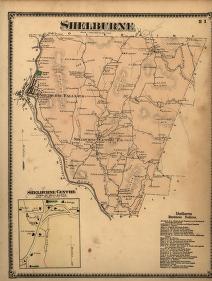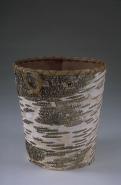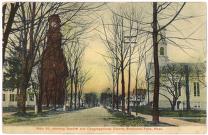|

"Shelburne"

"Buckland"

Shelburne Falls, Mass Birds-Eye View

Mason Jar

Carving Fork

Birch bark waste paper basket

Main Street, showing Baptist and Congregational Church, Shelburne Falls, Mass.

Electric Car Bridge over Deerfield River, Shelburne Falls, Mass.

No. 4-Bridge Street Shelburne Falls, Mass.
|
Summary and Objective
In this lesson, students will examine primary sources that provide information about what life may have been like for Ida Miller, a single lady who lived at 10 High Street in Shelburne Falls, a village that is part of two western Massachusetts towns: Buckland (on the west bank of the Deerfield River), and Shelburne (on the Deerfield's east bank--the side Ida lived on). Ida was born in Dummerston, VT and moved with her parents to Shelburne Falls where she lived until her death in 1932, leaving a sum of money in a trust fund to benefit the residents of the Shelburne Falls Fire District. Students will understand that exploring common artifacts and historical documents can help create a picture of a person's life in a certain time and place.
Teaching Plan
Step 1.
Have students examine the maps of "Shelburne" and "Buckland," examining the Shelburne Falls village areas closely using the "Look closer" feature. Ask students what the maps show about what Shelburne Falls was like in 1871, when Ida was about 15. Then look at the "Birds-Eye View" lithograph of Shelburne Falls, created in 1877 when Ida was about 21. Using the "Look Closer" feature, help students find High Street, where Ida lived--heading east from the bridge (toward the top right of the picture), High Street is the 4th Street on the left.
Step 2.
Using a small collection of mason jars (or just the digital collection example), and cans and boxes of everyday food, discuss how John Mason's invention of the Mason jar in 1855 enabled people like Ida Miller to preserve food and how that impacted their daily lives.
Step 3.
Read online about the Lamson & Goodnow carving fork manufactured c.1905 in Shelburne Falls and discuss how this company, by 1860 the largest cutlery producer in the nation, influenced life in the homes of Shelburne Falls residents like Ida Miller and her family.
Step 4.
Discuss the birchbark wastepaper basket and other items that Ida and her family might have purchased along the Mohawk Trail in the Shelburne Falls area, and how the purchase of these items affected the local economy as well as enhanced many local households.
Step 5.
Provide time for students to discuss the daily life of people living in Shelburne Falls and how these and other artifacts played an important role in their lives. You may want to have them look at the other digital collection items included here to think about what other activities people might have been involved in, or search the collection for other relevant items.
Step 6.
Students should write a paragraph describing the brief history and use of one household artifact at the turn of the century.
Step 7.
Make a classroom collection of old fashioned household artifacts that students bring in from home (or have a local antique dealer bring in some items and explain their use).
|




